Economics Homework: Demand, Supply, Elasticity and Equilibrium
VerifiedAdded on 2023/04/24
|11
|1464
|438
Homework Assignment
AI Summary
This economics assignment delves into the principles of demand and supply, analyzing market equilibrium and the impact of various factors. It examines the effects of changes in the price of substitute goods (leather jackets) and complementary goods on the market for woollen jumpers. The assignment further explores the impact of technological advancements in the knitting industry and changes in consumer income on the woollen jumper market. It also critically evaluates a statement regarding the garlic market, highlighting the distinction between shifts in demand and movements along the demand curve. Additionally, the assignment investigates the effects of bird flu on the live chicken market, considering both demand and supply-side implications. Finally, it calculates the price elasticity of demand and discusses its role in business decision-making for revenue maximization. The assignment concludes by examining the impact of new firm entry on industry profits, considering the role of entry barriers.
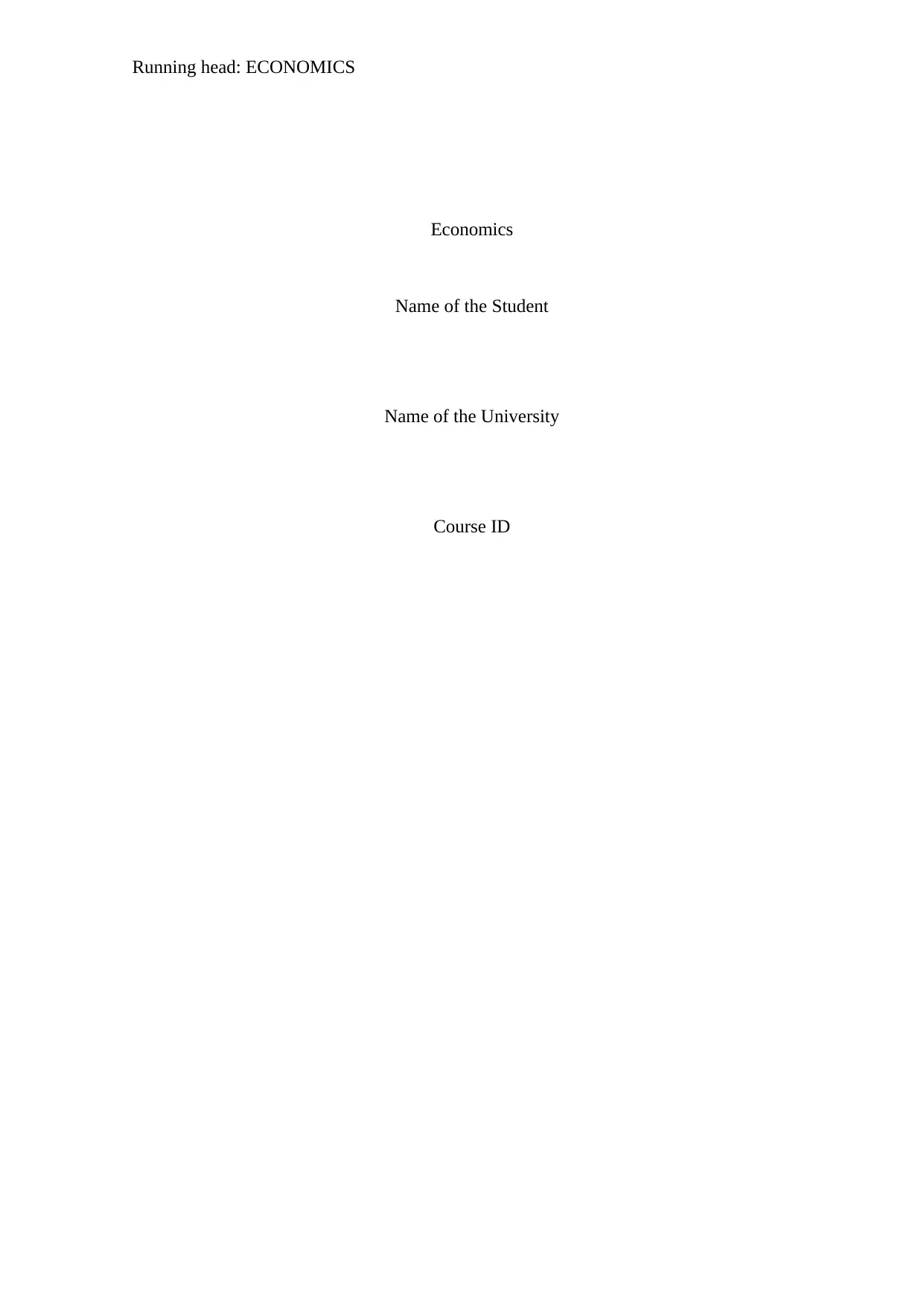
Running head: ECONOMICS
Economics
Name of the Student
Name of the University
Course ID
Economics
Name of the Student
Name of the University
Course ID
Paraphrase This Document
Need a fresh take? Get an instant paraphrase of this document with our AI Paraphraser
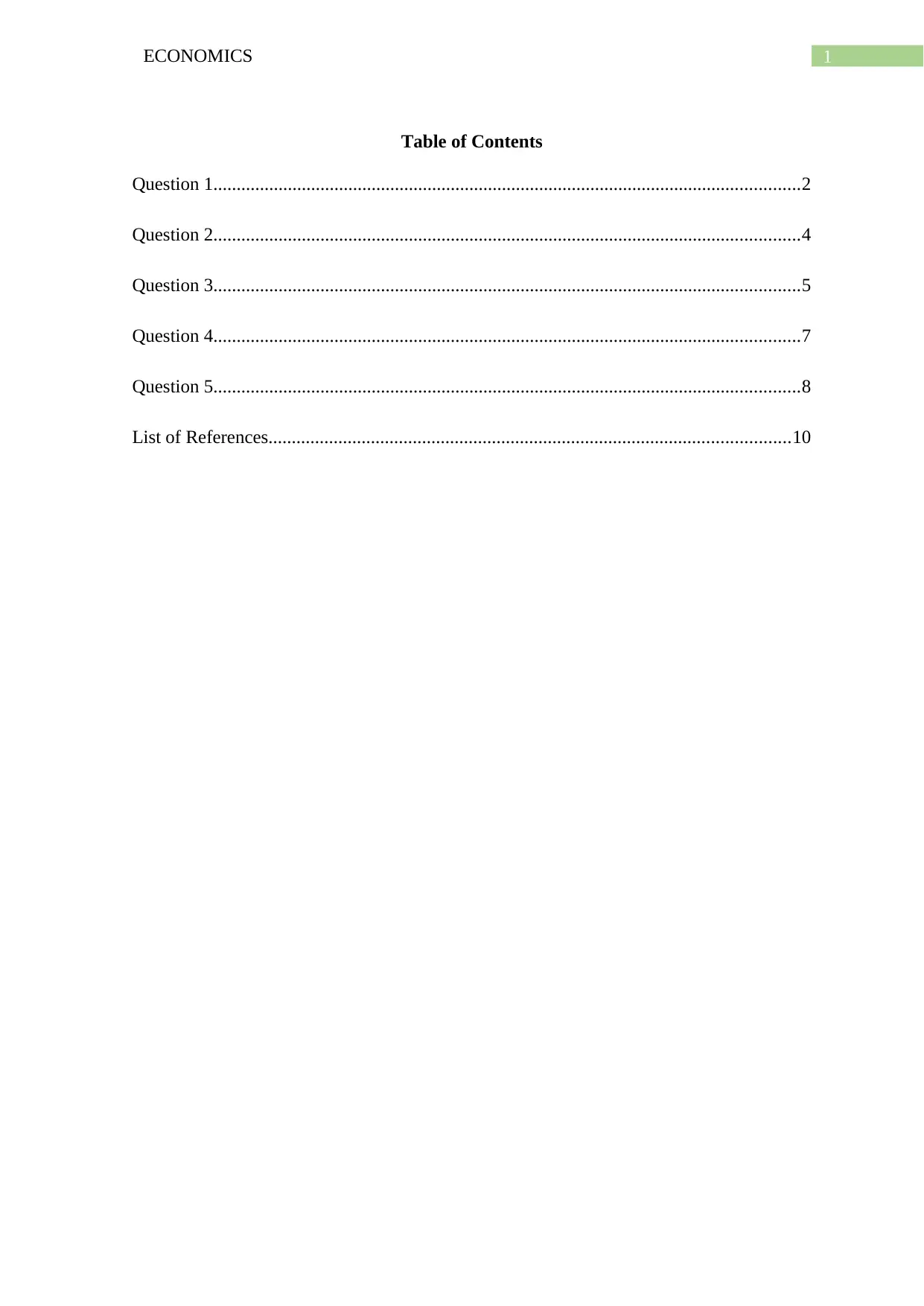
1ECONOMICS
Table of Contents
Question 1..............................................................................................................................2
Question 2..............................................................................................................................4
Question 3..............................................................................................................................5
Question 4..............................................................................................................................7
Question 5..............................................................................................................................8
List of References................................................................................................................10
Table of Contents
Question 1..............................................................................................................................2
Question 2..............................................................................................................................4
Question 3..............................................................................................................................5
Question 4..............................................................................................................................7
Question 5..............................................................................................................................8
List of References................................................................................................................10
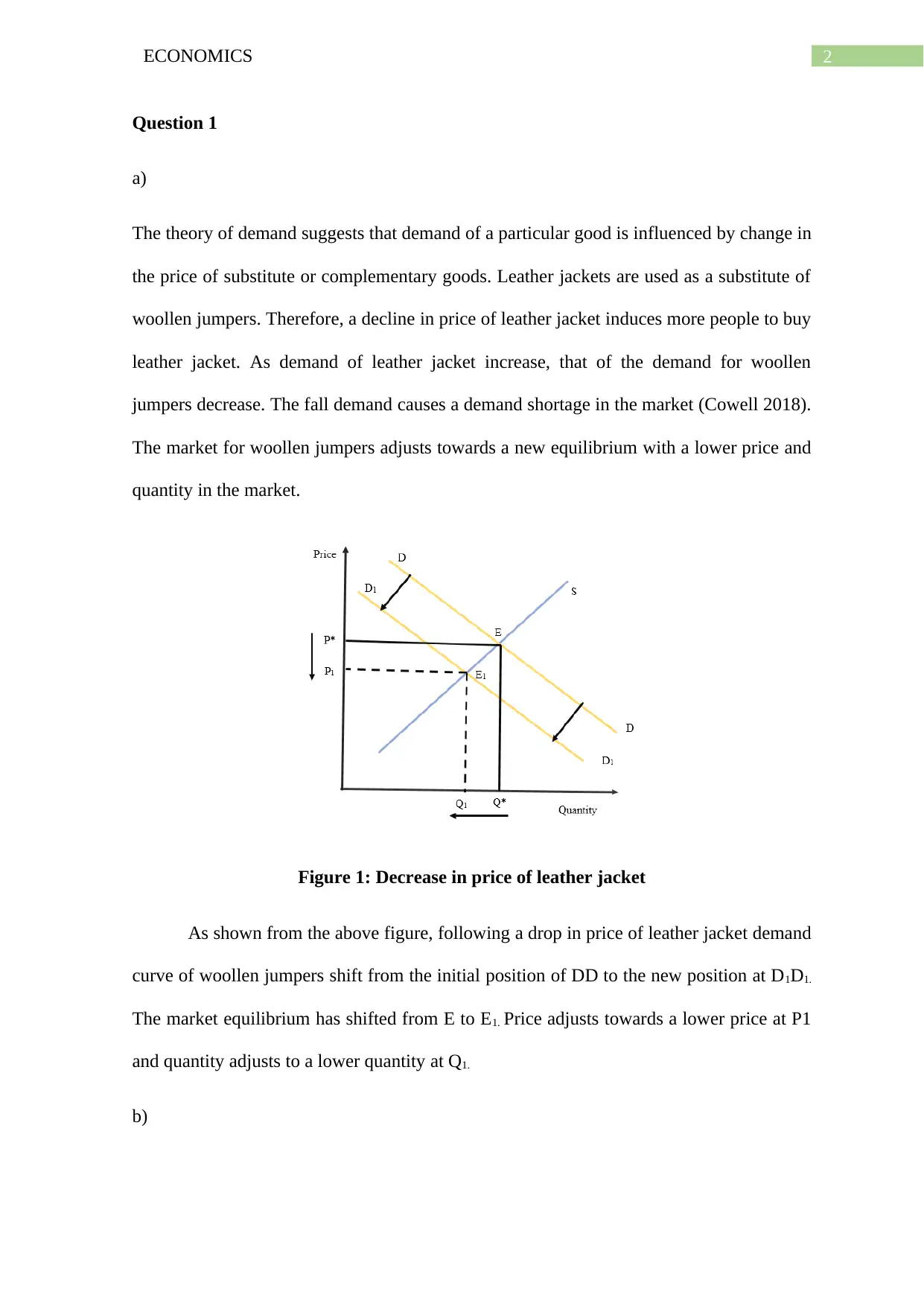
2ECONOMICS
Question 1
a)
The theory of demand suggests that demand of a particular good is influenced by change in
the price of substitute or complementary goods. Leather jackets are used as a substitute of
woollen jumpers. Therefore, a decline in price of leather jacket induces more people to buy
leather jacket. As demand of leather jacket increase, that of the demand for woollen
jumpers decrease. The fall demand causes a demand shortage in the market (Cowell 2018).
The market for woollen jumpers adjusts towards a new equilibrium with a lower price and
quantity in the market.
Figure 1: Decrease in price of leather jacket
As shown from the above figure, following a drop in price of leather jacket demand
curve of woollen jumpers shift from the initial position of DD to the new position at D1D1.
The market equilibrium has shifted from E to E1. Price adjusts towards a lower price at P1
and quantity adjusts to a lower quantity at Q1.
b)
Question 1
a)
The theory of demand suggests that demand of a particular good is influenced by change in
the price of substitute or complementary goods. Leather jackets are used as a substitute of
woollen jumpers. Therefore, a decline in price of leather jacket induces more people to buy
leather jacket. As demand of leather jacket increase, that of the demand for woollen
jumpers decrease. The fall demand causes a demand shortage in the market (Cowell 2018).
The market for woollen jumpers adjusts towards a new equilibrium with a lower price and
quantity in the market.
Figure 1: Decrease in price of leather jacket
As shown from the above figure, following a drop in price of leather jacket demand
curve of woollen jumpers shift from the initial position of DD to the new position at D1D1.
The market equilibrium has shifted from E to E1. Price adjusts towards a lower price at P1
and quantity adjusts to a lower quantity at Q1.
b)
⊘ This is a preview!⊘
Do you want full access?
Subscribe today to unlock all pages.

Trusted by 1+ million students worldwide
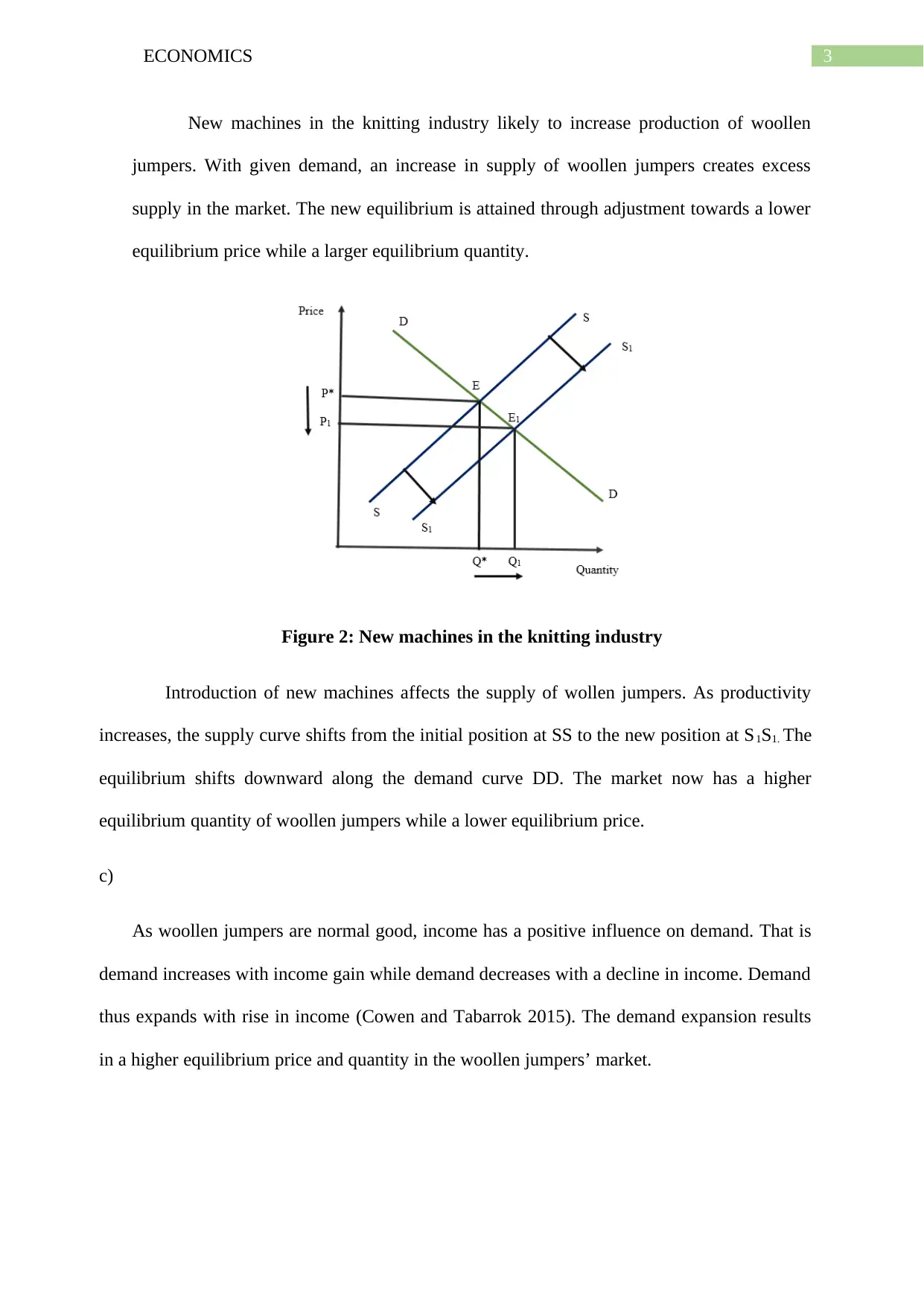
3ECONOMICS
New machines in the knitting industry likely to increase production of woollen
jumpers. With given demand, an increase in supply of woollen jumpers creates excess
supply in the market. The new equilibrium is attained through adjustment towards a lower
equilibrium price while a larger equilibrium quantity.
Figure 2: New machines in the knitting industry
Introduction of new machines affects the supply of wollen jumpers. As productivity
increases, the supply curve shifts from the initial position at SS to the new position at S1S1. The
equilibrium shifts downward along the demand curve DD. The market now has a higher
equilibrium quantity of woollen jumpers while a lower equilibrium price.
c)
As woollen jumpers are normal good, income has a positive influence on demand. That is
demand increases with income gain while demand decreases with a decline in income. Demand
thus expands with rise in income (Cowen and Tabarrok 2015). The demand expansion results
in a higher equilibrium price and quantity in the woollen jumpers’ market.
New machines in the knitting industry likely to increase production of woollen
jumpers. With given demand, an increase in supply of woollen jumpers creates excess
supply in the market. The new equilibrium is attained through adjustment towards a lower
equilibrium price while a larger equilibrium quantity.
Figure 2: New machines in the knitting industry
Introduction of new machines affects the supply of wollen jumpers. As productivity
increases, the supply curve shifts from the initial position at SS to the new position at S1S1. The
equilibrium shifts downward along the demand curve DD. The market now has a higher
equilibrium quantity of woollen jumpers while a lower equilibrium price.
c)
As woollen jumpers are normal good, income has a positive influence on demand. That is
demand increases with income gain while demand decreases with a decline in income. Demand
thus expands with rise in income (Cowen and Tabarrok 2015). The demand expansion results
in a higher equilibrium price and quantity in the woollen jumpers’ market.
Paraphrase This Document
Need a fresh take? Get an instant paraphrase of this document with our AI Paraphraser
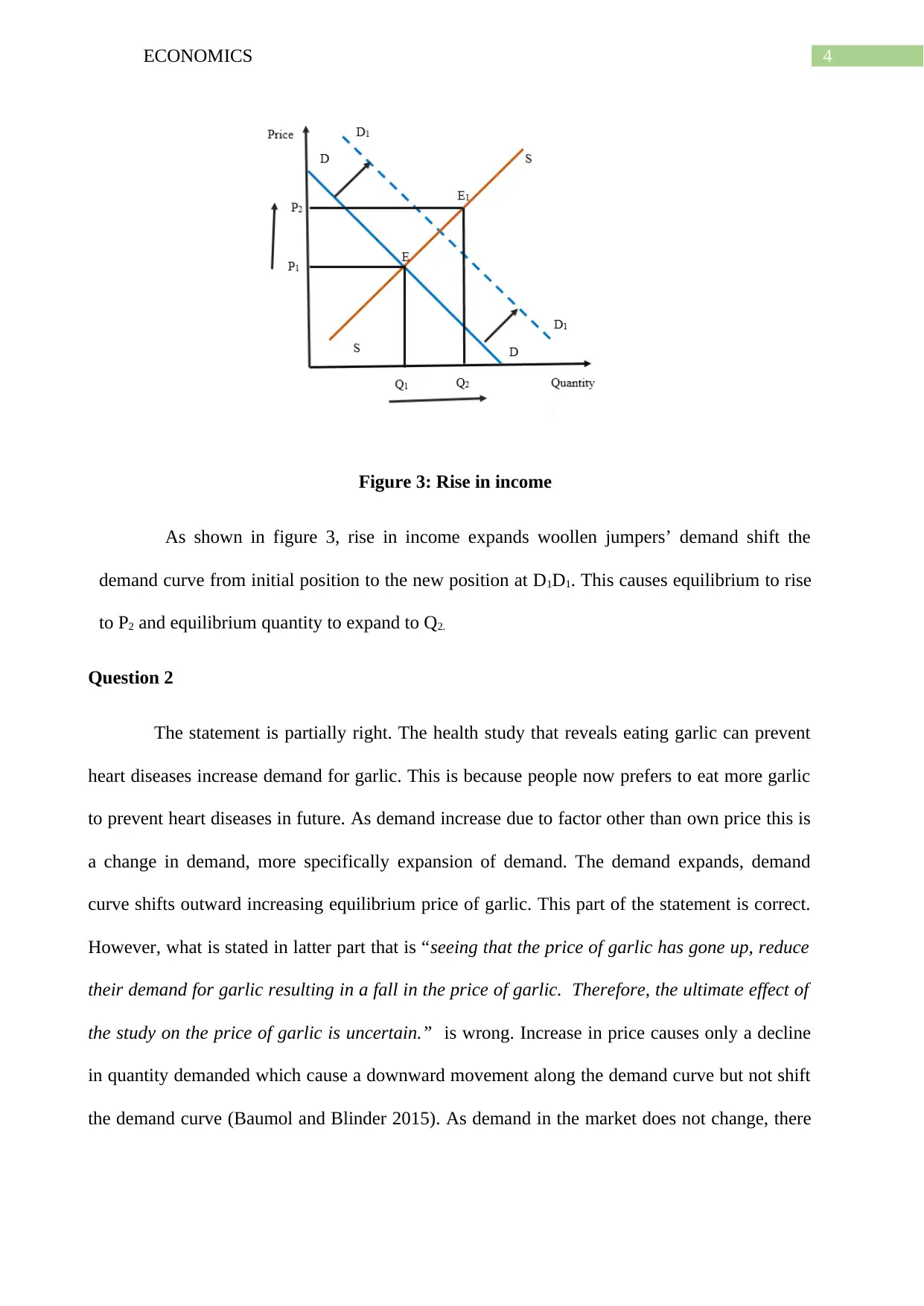
4ECONOMICS
Figure 3: Rise in income
As shown in figure 3, rise in income expands woollen jumpers’ demand shift the
demand curve from initial position to the new position at D1D1. This causes equilibrium to rise
to P2 and equilibrium quantity to expand to Q2.
Question 2
The statement is partially right. The health study that reveals eating garlic can prevent
heart diseases increase demand for garlic. This is because people now prefers to eat more garlic
to prevent heart diseases in future. As demand increase due to factor other than own price this is
a change in demand, more specifically expansion of demand. The demand expands, demand
curve shifts outward increasing equilibrium price of garlic. This part of the statement is correct.
However, what is stated in latter part that is “seeing that the price of garlic has gone up, reduce
their demand for garlic resulting in a fall in the price of garlic. Therefore, the ultimate effect of
the study on the price of garlic is uncertain.” is wrong. Increase in price causes only a decline
in quantity demanded which cause a downward movement along the demand curve but not shift
the demand curve (Baumol and Blinder 2015). As demand in the market does not change, there
Figure 3: Rise in income
As shown in figure 3, rise in income expands woollen jumpers’ demand shift the
demand curve from initial position to the new position at D1D1. This causes equilibrium to rise
to P2 and equilibrium quantity to expand to Q2.
Question 2
The statement is partially right. The health study that reveals eating garlic can prevent
heart diseases increase demand for garlic. This is because people now prefers to eat more garlic
to prevent heart diseases in future. As demand increase due to factor other than own price this is
a change in demand, more specifically expansion of demand. The demand expands, demand
curve shifts outward increasing equilibrium price of garlic. This part of the statement is correct.
However, what is stated in latter part that is “seeing that the price of garlic has gone up, reduce
their demand for garlic resulting in a fall in the price of garlic. Therefore, the ultimate effect of
the study on the price of garlic is uncertain.” is wrong. Increase in price causes only a decline
in quantity demanded which cause a downward movement along the demand curve but not shift
the demand curve (Baumol and Blinder 2015). As demand in the market does not change, there
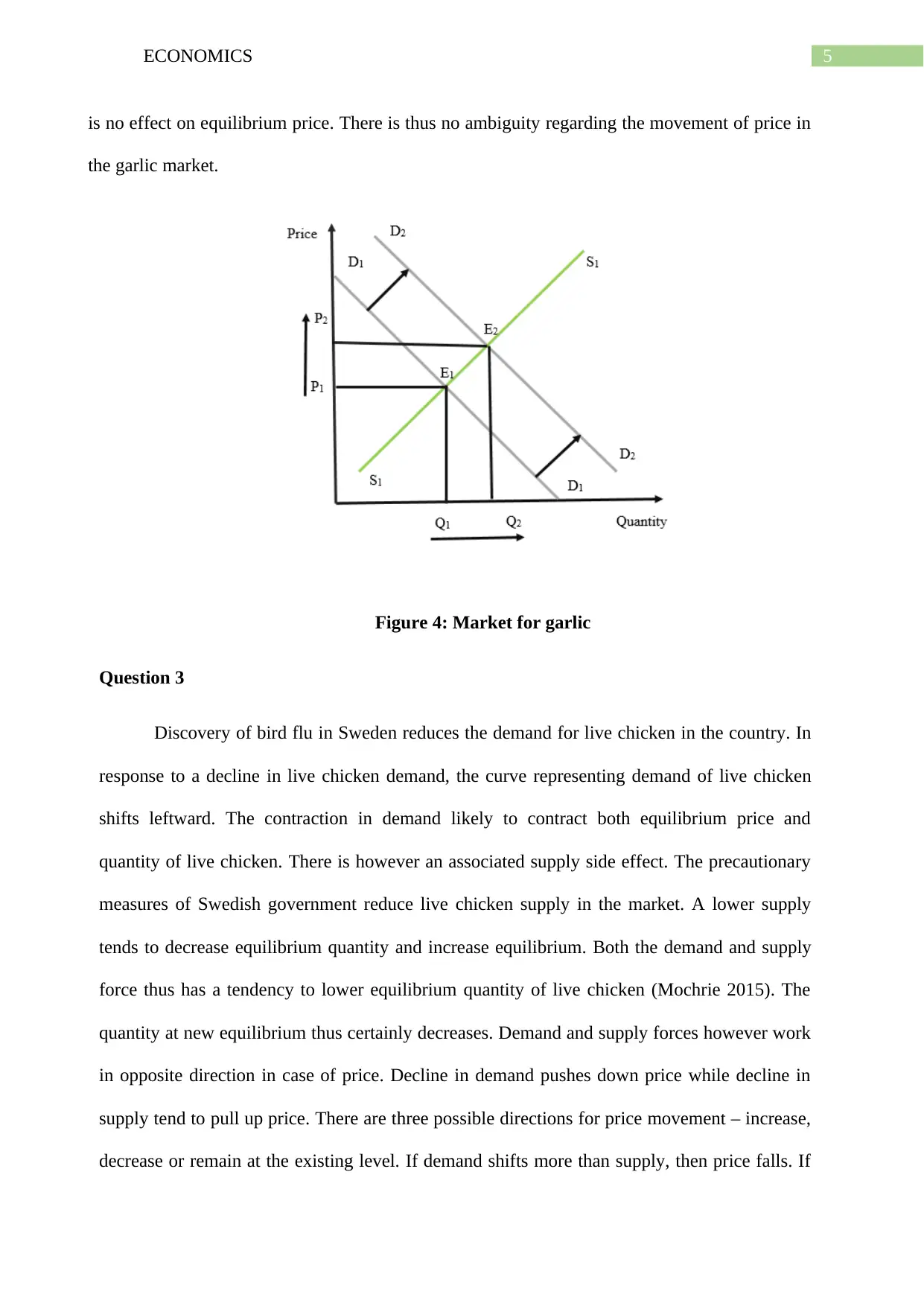
5ECONOMICS
is no effect on equilibrium price. There is thus no ambiguity regarding the movement of price in
the garlic market.
Figure 4: Market for garlic
Question 3
Discovery of bird flu in Sweden reduces the demand for live chicken in the country. In
response to a decline in live chicken demand, the curve representing demand of live chicken
shifts leftward. The contraction in demand likely to contract both equilibrium price and
quantity of live chicken. There is however an associated supply side effect. The precautionary
measures of Swedish government reduce live chicken supply in the market. A lower supply
tends to decrease equilibrium quantity and increase equilibrium. Both the demand and supply
force thus has a tendency to lower equilibrium quantity of live chicken (Mochrie 2015). The
quantity at new equilibrium thus certainly decreases. Demand and supply forces however work
in opposite direction in case of price. Decline in demand pushes down price while decline in
supply tend to pull up price. There are three possible directions for price movement – increase,
decrease or remain at the existing level. If demand shifts more than supply, then price falls. If
is no effect on equilibrium price. There is thus no ambiguity regarding the movement of price in
the garlic market.
Figure 4: Market for garlic
Question 3
Discovery of bird flu in Sweden reduces the demand for live chicken in the country. In
response to a decline in live chicken demand, the curve representing demand of live chicken
shifts leftward. The contraction in demand likely to contract both equilibrium price and
quantity of live chicken. There is however an associated supply side effect. The precautionary
measures of Swedish government reduce live chicken supply in the market. A lower supply
tends to decrease equilibrium quantity and increase equilibrium. Both the demand and supply
force thus has a tendency to lower equilibrium quantity of live chicken (Mochrie 2015). The
quantity at new equilibrium thus certainly decreases. Demand and supply forces however work
in opposite direction in case of price. Decline in demand pushes down price while decline in
supply tend to pull up price. There are three possible directions for price movement – increase,
decrease or remain at the existing level. If demand shifts more than supply, then price falls. If
⊘ This is a preview!⊘
Do you want full access?
Subscribe today to unlock all pages.

Trusted by 1+ million students worldwide
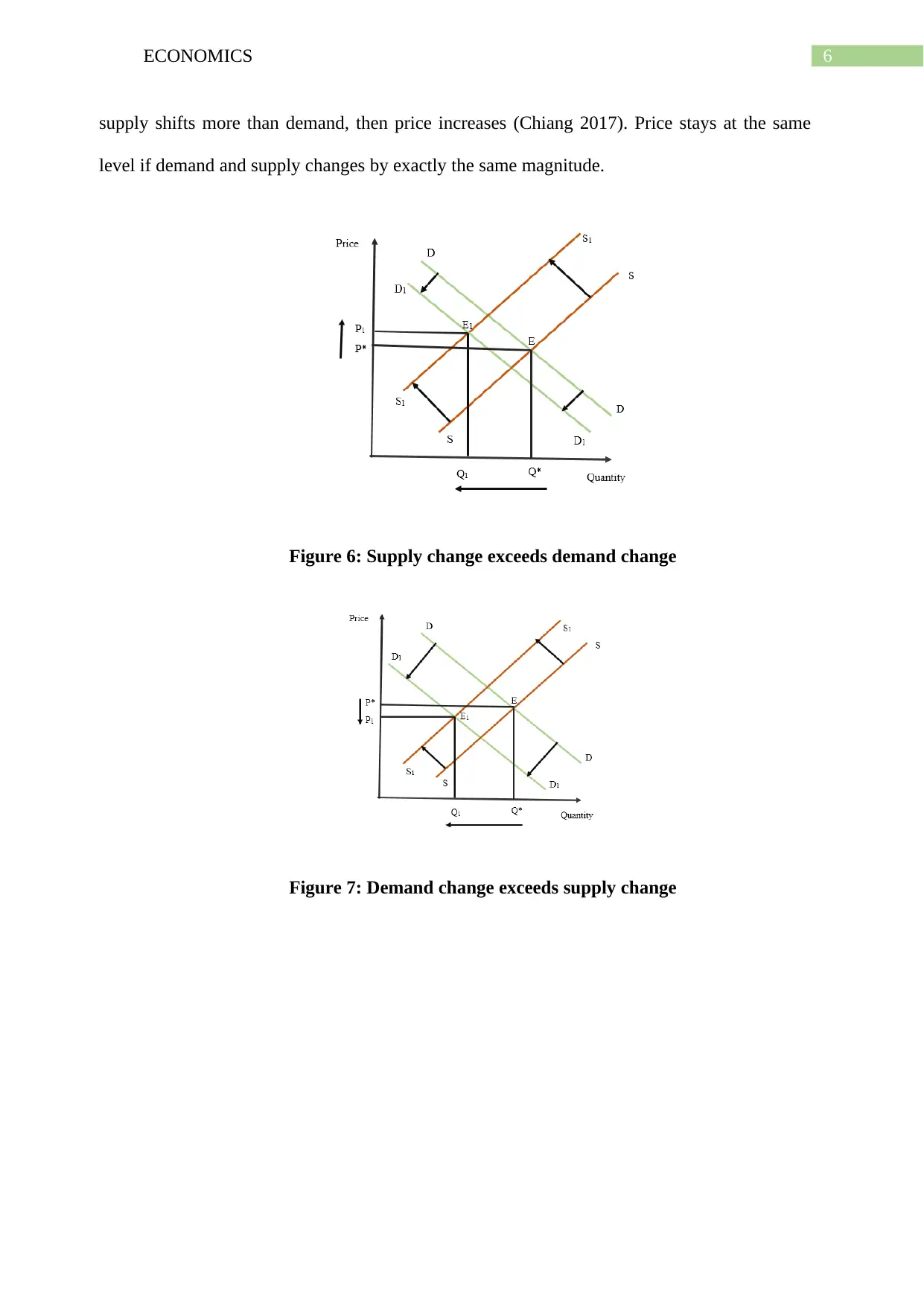
6ECONOMICS
supply shifts more than demand, then price increases (Chiang 2017). Price stays at the same
level if demand and supply changes by exactly the same magnitude.
Figure 6: Supply change exceeds demand change
Figure 7: Demand change exceeds supply change
supply shifts more than demand, then price increases (Chiang 2017). Price stays at the same
level if demand and supply changes by exactly the same magnitude.
Figure 6: Supply change exceeds demand change
Figure 7: Demand change exceeds supply change
Paraphrase This Document
Need a fresh take? Get an instant paraphrase of this document with our AI Paraphraser
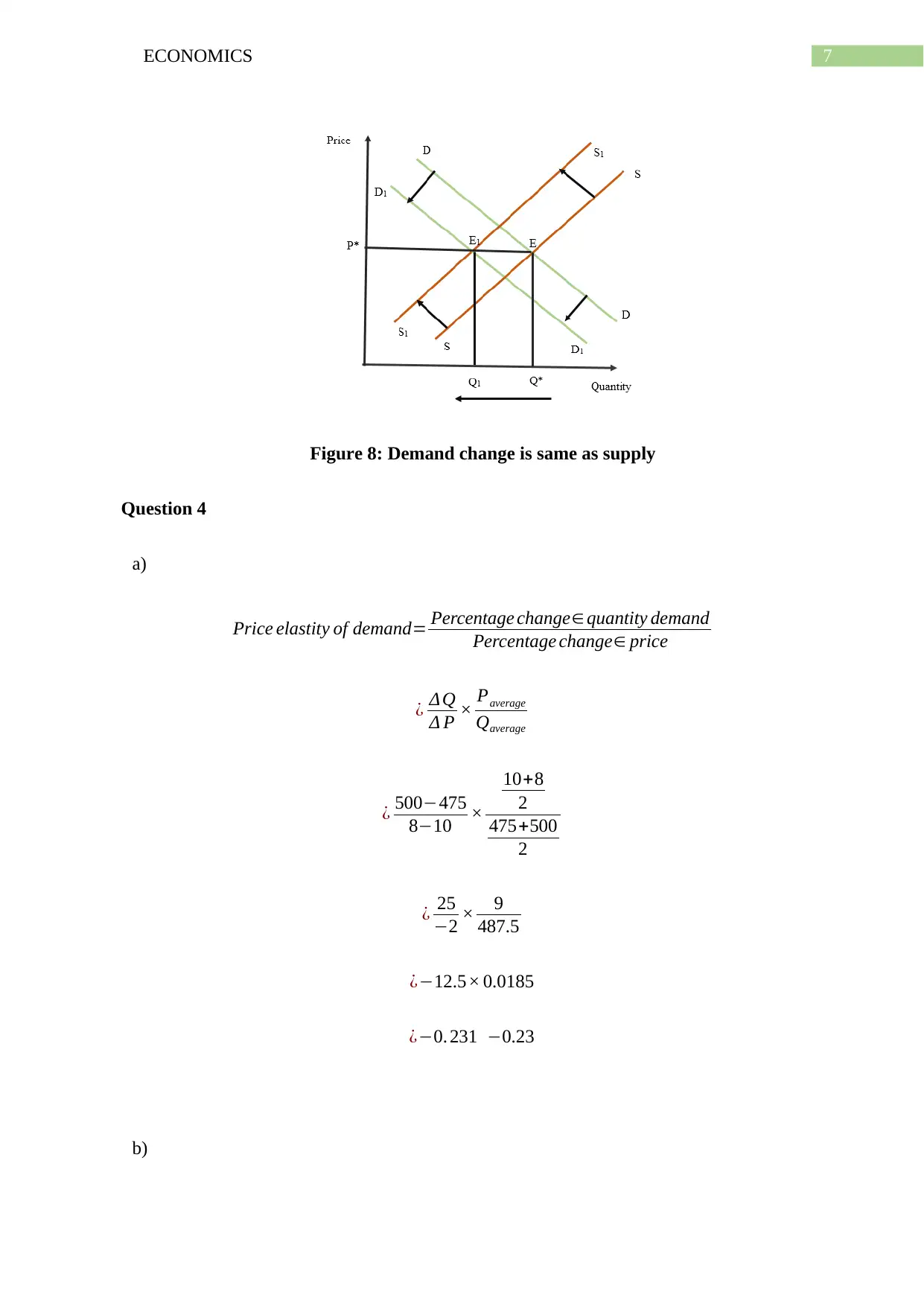
7ECONOMICS
Figure 8: Demand change is same as supply
Question 4
a)
Price elastity of demand= Percentage change∈ quantity demand
Percentage change∈ price
¿ Δ Q
Δ P × Paverage
Qaverage
¿ 500−475
8−10 ×
10+8
2
475+500
2
¿ 25
−2 × 9
487.5
¿−12.5× 0.0185
¿−0. 231 −0.23
b)
Figure 8: Demand change is same as supply
Question 4
a)
Price elastity of demand= Percentage change∈ quantity demand
Percentage change∈ price
¿ Δ Q
Δ P × Paverage
Qaverage
¿ 500−475
8−10 ×
10+8
2
475+500
2
¿ 25
−2 × 9
487.5
¿−12.5× 0.0185
¿−0. 231 −0.23
b)
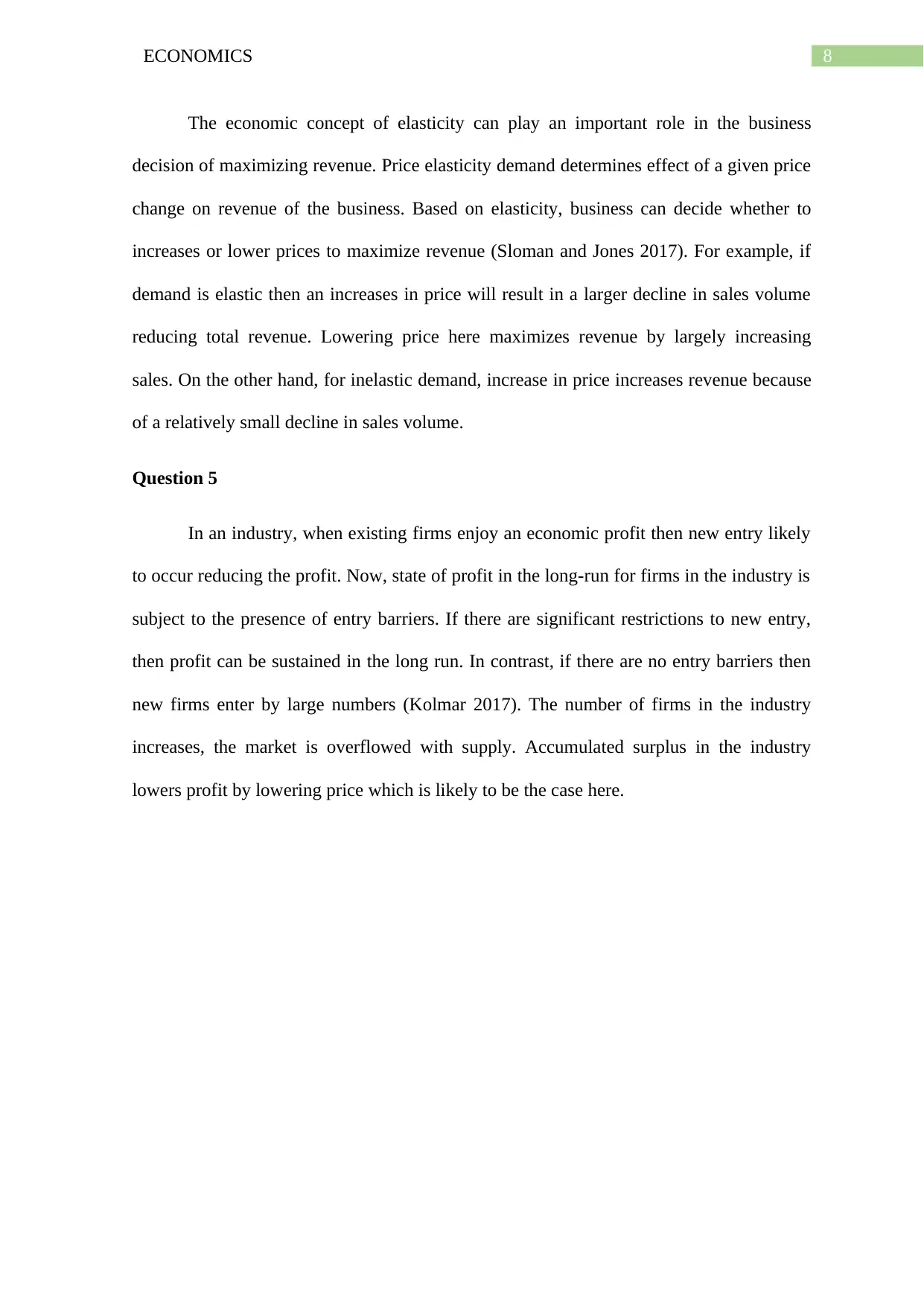
8ECONOMICS
The economic concept of elasticity can play an important role in the business
decision of maximizing revenue. Price elasticity demand determines effect of a given price
change on revenue of the business. Based on elasticity, business can decide whether to
increases or lower prices to maximize revenue (Sloman and Jones 2017). For example, if
demand is elastic then an increases in price will result in a larger decline in sales volume
reducing total revenue. Lowering price here maximizes revenue by largely increasing
sales. On the other hand, for inelastic demand, increase in price increases revenue because
of a relatively small decline in sales volume.
Question 5
In an industry, when existing firms enjoy an economic profit then new entry likely
to occur reducing the profit. Now, state of profit in the long-run for firms in the industry is
subject to the presence of entry barriers. If there are significant restrictions to new entry,
then profit can be sustained in the long run. In contrast, if there are no entry barriers then
new firms enter by large numbers (Kolmar 2017). The number of firms in the industry
increases, the market is overflowed with supply. Accumulated surplus in the industry
lowers profit by lowering price which is likely to be the case here.
The economic concept of elasticity can play an important role in the business
decision of maximizing revenue. Price elasticity demand determines effect of a given price
change on revenue of the business. Based on elasticity, business can decide whether to
increases or lower prices to maximize revenue (Sloman and Jones 2017). For example, if
demand is elastic then an increases in price will result in a larger decline in sales volume
reducing total revenue. Lowering price here maximizes revenue by largely increasing
sales. On the other hand, for inelastic demand, increase in price increases revenue because
of a relatively small decline in sales volume.
Question 5
In an industry, when existing firms enjoy an economic profit then new entry likely
to occur reducing the profit. Now, state of profit in the long-run for firms in the industry is
subject to the presence of entry barriers. If there are significant restrictions to new entry,
then profit can be sustained in the long run. In contrast, if there are no entry barriers then
new firms enter by large numbers (Kolmar 2017). The number of firms in the industry
increases, the market is overflowed with supply. Accumulated surplus in the industry
lowers profit by lowering price which is likely to be the case here.
⊘ This is a preview!⊘
Do you want full access?
Subscribe today to unlock all pages.

Trusted by 1+ million students worldwide
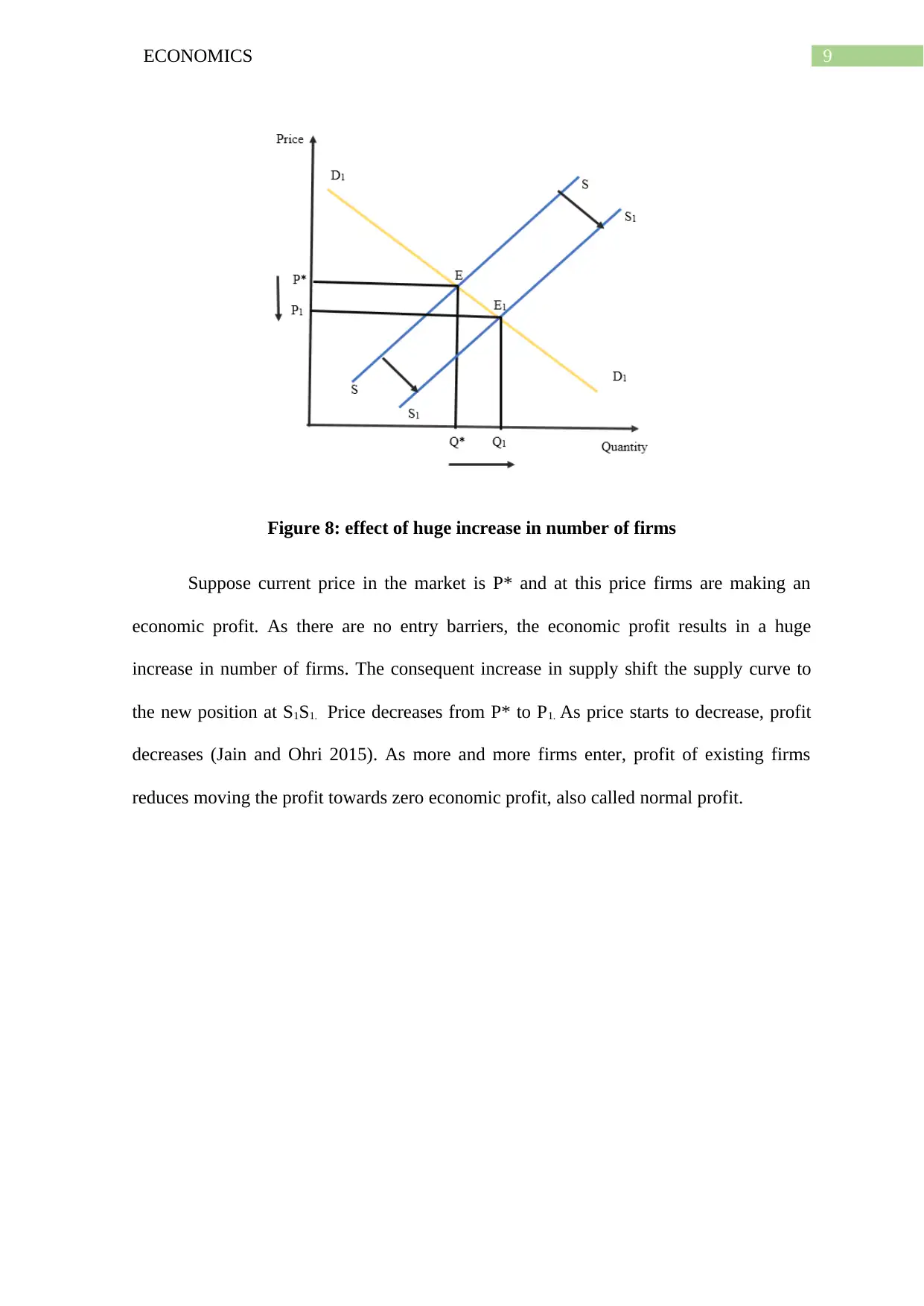
9ECONOMICS
Figure 8: effect of huge increase in number of firms
Suppose current price in the market is P* and at this price firms are making an
economic profit. As there are no entry barriers, the economic profit results in a huge
increase in number of firms. The consequent increase in supply shift the supply curve to
the new position at S1S1. Price decreases from P* to P1. As price starts to decrease, profit
decreases (Jain and Ohri 2015). As more and more firms enter, profit of existing firms
reduces moving the profit towards zero economic profit, also called normal profit.
Figure 8: effect of huge increase in number of firms
Suppose current price in the market is P* and at this price firms are making an
economic profit. As there are no entry barriers, the economic profit results in a huge
increase in number of firms. The consequent increase in supply shift the supply curve to
the new position at S1S1. Price decreases from P* to P1. As price starts to decrease, profit
decreases (Jain and Ohri 2015). As more and more firms enter, profit of existing firms
reduces moving the profit towards zero economic profit, also called normal profit.
Paraphrase This Document
Need a fresh take? Get an instant paraphrase of this document with our AI Paraphraser
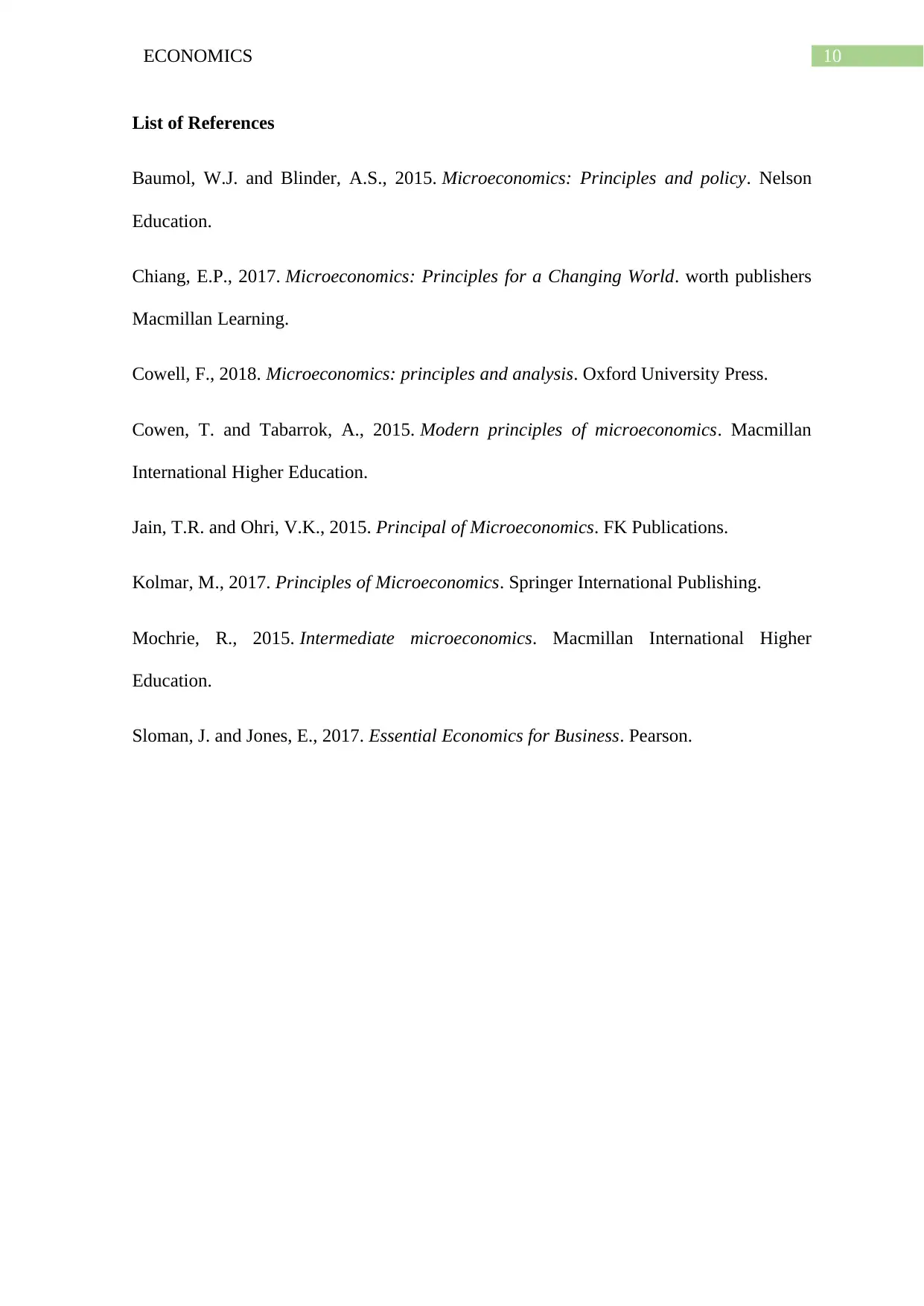
10ECONOMICS
List of References
Baumol, W.J. and Blinder, A.S., 2015. Microeconomics: Principles and policy. Nelson
Education.
Chiang, E.P., 2017. Microeconomics: Principles for a Changing World. worth publishers
Macmillan Learning.
Cowell, F., 2018. Microeconomics: principles and analysis. Oxford University Press.
Cowen, T. and Tabarrok, A., 2015. Modern principles of microeconomics. Macmillan
International Higher Education.
Jain, T.R. and Ohri, V.K., 2015. Principal of Microeconomics. FK Publications.
Kolmar, M., 2017. Principles of Microeconomics. Springer International Publishing.
Mochrie, R., 2015. Intermediate microeconomics. Macmillan International Higher
Education.
Sloman, J. and Jones, E., 2017. Essential Economics for Business. Pearson.
List of References
Baumol, W.J. and Blinder, A.S., 2015. Microeconomics: Principles and policy. Nelson
Education.
Chiang, E.P., 2017. Microeconomics: Principles for a Changing World. worth publishers
Macmillan Learning.
Cowell, F., 2018. Microeconomics: principles and analysis. Oxford University Press.
Cowen, T. and Tabarrok, A., 2015. Modern principles of microeconomics. Macmillan
International Higher Education.
Jain, T.R. and Ohri, V.K., 2015. Principal of Microeconomics. FK Publications.
Kolmar, M., 2017. Principles of Microeconomics. Springer International Publishing.
Mochrie, R., 2015. Intermediate microeconomics. Macmillan International Higher
Education.
Sloman, J. and Jones, E., 2017. Essential Economics for Business. Pearson.
1 out of 11
Related Documents
Your All-in-One AI-Powered Toolkit for Academic Success.
+13062052269
info@desklib.com
Available 24*7 on WhatsApp / Email
![[object Object]](/_next/static/media/star-bottom.7253800d.svg)
Unlock your academic potential
Copyright © 2020–2025 A2Z Services. All Rights Reserved. Developed and managed by ZUCOL.





